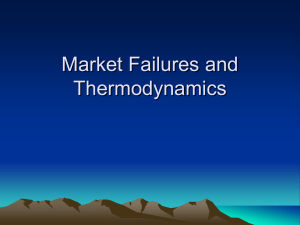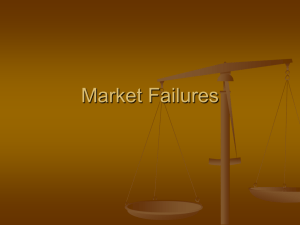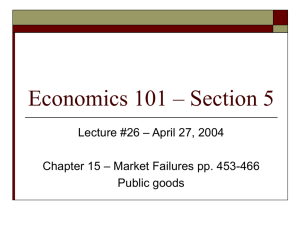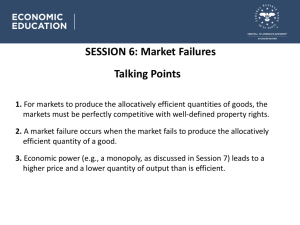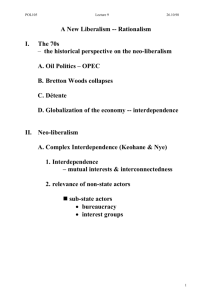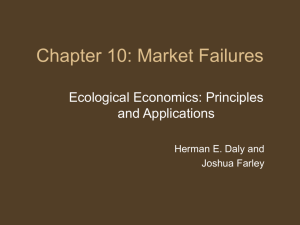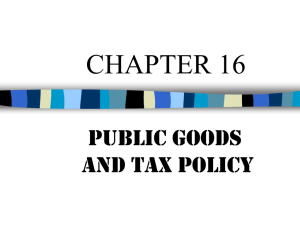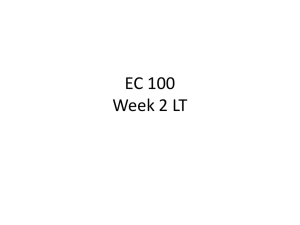Market Failures and Thermodynamics
advertisement
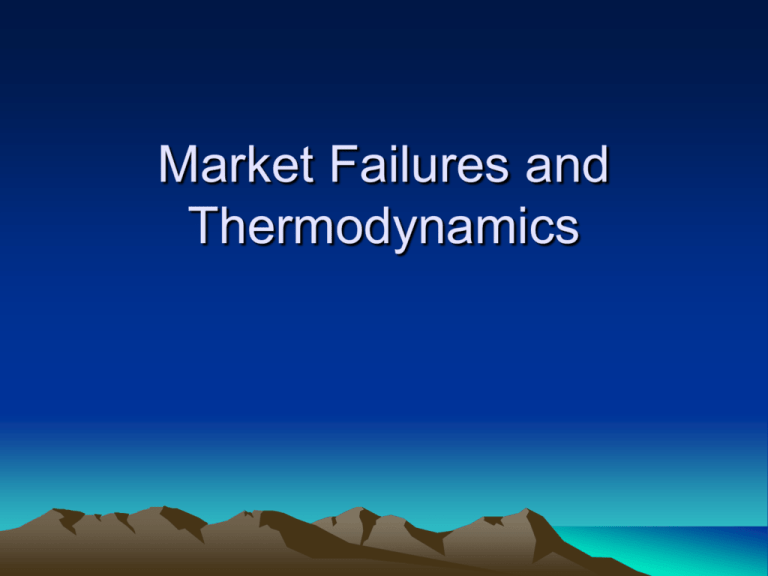
Market Failures and Thermodynamics Quick Review Which of the following statements about excludability is true? A. Use of a non-excludable resource by one person does not leave less for others B. Some resources are inherently excludable, while others are inherently non-excludable C. No stock-flow resources are nonexcludable D. All fund-service resources are nonexcludable E. Non-excludable resources are subject to free riding Which of the following statements about Rivalness is true? A. Markets are only possible for rival resources B. A resource is rival if my use does not leave less for you to use C. Economic surplus from a non-rival good is maximized at a price of zero D. Non-rival resources must be transformed into rival resources in order for markets to be efficient E. All ecosystem services are non-rival Rivalness • Anti rival (additive) – My use makes you better off – What's an example? • Abundance, scarcity and rivalry – Rival and abundant: oxygen – Rival and borderline: Crowded beach – Rival and scarce: oil So What? Excludable Rival Non-rival, Anti-rival Market Good: cars, houses, land, oil, timber, waste absorption capacity? Tragedy of the noncommons: property rights to genetic info., patented information, e.g. nonozone dep. comp. Toll Good, club good: Congestible Roads, parks, beaches. natural monopolies. Non-Excludable Open Access Regime: Oceanic fisheries, timber etc. from unprotected forests, waste absorption capacity Pure Public Good: Information, most ecosystem services, e.g. climate stability, coastline protection, life support functions, etc. Free Rider Problem Open Access • The “Tragedy of the commons” • Common property vs. open access Solutions to Open Access • Rival and scarce resources must be rationed • Rationing requires property rights – Public, private or common • Private property allows markets and price rationing – Who gets ownership? Public Goods • Free-riding • No price signal as feed-back mechanism – Scarcity price increase innovation •Lack of Incentives to produce them •Lack of incentives to create technologies that provide them Public Goods (cont.) • Free-market enthusiasts don’t deny public good problem, but claim they are relatively unimportant • Increasing scale and public goods • Are stable climate, ozone layer, disturbance regulation (e.g. storm protection) and other life support functions relatively unimportant? Solutions for Public Goods • Public goods created by rival, scarce resources – Ecosystem structure – Built infrastructure – Human capital • Requires public investment in production and protection • Public goods generate non-rival services – Rationing inefficient – Open access is efficient Non-rival & Excludable: tragedy of the non-commons • Why do we have patents? • When did patents come about? – 1790s in US – 1947 international, rarely used before 1980s Patents: efficiency and sustainability • Create inadequate incentives for inventions that provide or preserve public goods • Raise costs for research – Profit motive prevents sharing of knowledge • Monopolies on non-rival resource – Expensive to enforce • Prices ration use • Examples: new technology for highly efficient solar energy; non-ozone depleting technologies; Indonesia’s avian flu Patents and just distribution • Samuel Slater, “Father of American Industry” • Developed countries own 97% of all patents • Raises costs for research that meets the needs of the poor – Golden corn • “Standing on the shoulders of giants” Solution to Tragedy of Noncommons • Public investment, common ownership • Land grant universities, e.g. UVM • Rate of return on investments in public sector agriculture R&D 60-80% per year Natural Monopolies • Excludable • Rival but abundant (Congestible) – High fixed costs – Low marginal costs Market goods: The theory of Externalities Externalities • Definition – “an activity by one agent causes a loss (gain) of welfare to another agent” – “The loss (gain) of welfare is uncompensated” • Completely Internal to the Economic Process. Why? • Externalities and profit maximization • How are these related to public goods? Example: Conversion of Mangrove Ecosystems to Shrimp Aquaculture Values of Natural Capital: Mangrove Ecosystems •Structure, raw materials, stock-flow resources •Building materials, charcoal, food •Function, ecosystem services, fundservices •Habitat, nursery •Storm protection •Waste absorption •Climate stabilization Values of Conversion Shrimp Aquaculture •High short term profits, heavily promoted by economists •Shrimp and fish for 3-5 years •Carnivorous, net reduction in food production •Less protein than intact ecosystem •Massive waste output •Irreversible(?) destruction of ecosystem •Why convert? Impact of Conversion •On natural capital: •Loss of Ecosystem services •Loss of fish production •On social capital? •On human capital ‘Optimal’ pollution/degradation Solutions for Externalities: Regulations • Best management practices • Best available technologies • Caps on resource extraction, waste emissions, e.g. no conversion of mangroves to shrimp aquaculture • Non-market mechanism. Producers cannot adjust MC to equal MB Market Solution: Property Rights • Who owns the environment? • polluter ‘rights’ • sufferer rights • What about future generations? Market Option I: Property Rights Shrimp aquaculture Problems with property rights • Transaction costs – in absence of transaction costs, no negative externalities – What are transaction costs likely to be for externalities affecting public goods? • Wealth effect • Intergenerational externalities Market Solutions 2: Pigouvian Taxes • Tax externalities – Ideal tax = marginal cost, e.g. gas tax $12.00 gallon – Can costs be measured in monetary terms? • Basic idea – Set price, let this determine Q at which demand = price – Price determines scale ‘Market’ Option 2: Pigouvian tax: Getting prices right tax Market Solutions 3: Cap and trade/ Cap and auction • 3 steps – Sustainable scale: Set cap – Just distribution: determine property rights, e.g. do resources belong to those who exploit them, or to public? – Efficient allocation: Tradable quotas (Cap and Trade) or public auctions (cap and auction) • Basic rule: scale is price determining 'Market' Option 3: Tradable Quotas: setting ecologically sustainable scale quota What’s better, tax or quota? • Prices adjust to ecological constraints faster then ecosystems adjust to economic impacts • Distributional impacts – Taxes – Quotas Ignorance and Uncertainty • Perfect markets require perfect information • Asymmetric information – Nobel Prize in 2000 – Theory of the Lemon • • • • Irreducible ignorance Time lags Ecosystem function Solution: better information flows, precautionary principle Asymmetric Preference Formation • What forms our preferences? • In what direction are our preferences pushed, towards market or non-market goods? • Solution: balanced information flows Missing markets • For a market to work, everyone must be able to participate • Future generations can’t participate in today’s markets • People without money cannot participate, e.g. many indigenous peoples • How much would the Mona Lisa sell for if it were auctioned off in St. Albans? • Solution: inalienable property rights for future generations
